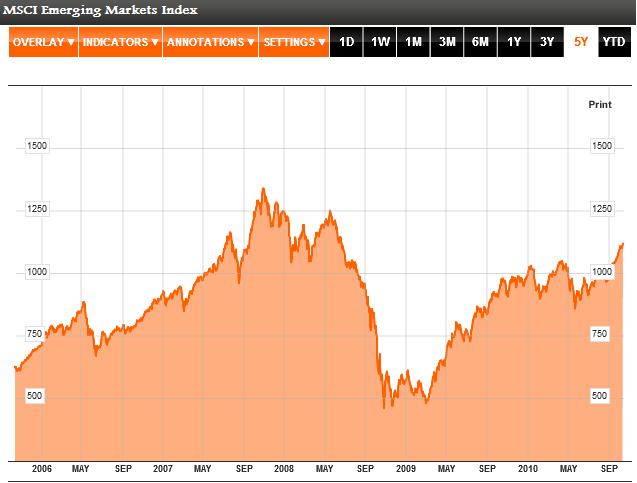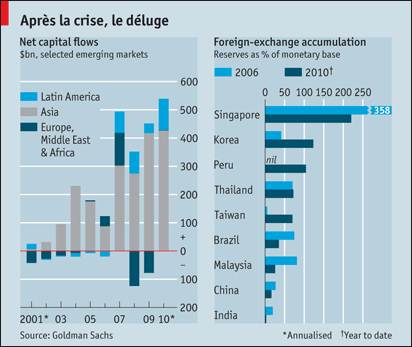October 14th 2010
Emerging Market “Wall of Money” Spurs Currency War
According to Goldman Sachs (which if nothing else, is good at characterizing financial trends. Remember “BRIC?”), there is a “Wall of Money” that is already flooding emerging markets and will continue to do so for the foreseeable future.

“The Institute of International Finance projected 2010 capital flows of $825 billion, up from $581 billion in 2009 and from the $709 billion that the trade group for global financial-services firms had projected for 2010 in April.” In hindsight, the outflow of capital from emerging markets that took place during the financial crisis will probably look like a blip, as risk appetite has already recovered to pre-crisis levels, and then some!
“The move into emerging markets has been led by stock investors, who will pour an estimated $186 billion into these countries this year, — fully three times the annual average of $62 billion generated between 2005 and 2009.” Emerging Market Bond funds, meanwhile, now routinely receive more than $1 Billion per week. Sovereign wealth funds are also starting to shift some of their assets into emerging market assets/currencies as part of their respective diversification strategies. As you can see from the chart below (courtesy of The Economist), Asia is by far the largest recipient of investment, followed by Latin America.

The continued shift of capital from the industrialized world into emerging markets as being driven both by economic fundamentals and the desire to earn a greater return on investment. “The IMF forecast this month that developing nations will expand 6.4 percent next year, outstripping growth of 2.2 percent among advanced economies.” Meanwhile, the ratio of foreign debt to GDP among developing nations has been cut to 26 percent, compared to 41 percent in 1999. And yet, even as analysts predict that emerging markets will account for 85% of global growth going forward, “emerging markets account for $3 trillion, or only 15 percent of market capitalisation of the benchmark MSCI world index.”
While it’s understandable, then, that investors would want to rectify this imbalance as quickly as possible, they need to realize that developing countries’ capital markets simply aren’t deep enough to absorb all of the incoming capital. In other words, an limited pool of capital is chasing a limited stock of accessible investments, and the result is that asset prices and exchange rates are climbing inexorably higher.
Analysts argue, “Some appreciation is due: a rise against rich-world currencies is both a natural consequence of the faster growth of emerging economies and a way to correct global imbalances.” But a 50% rise over five years (notched by a handful of currencies) does not represent some appreciation, but rather an explosion. This is precisely the sentiment echoed by many of the emerging markets, themselves, which have taken to using guerilla tactics to hold down their currencies. Since the latest phase of the “currency war” was ignited by Japan in September, every week has led to increasingly far-flung countries – Peru, Chile, Czech Republic, Poland, South Africa – reputedly contemplating intervention.
According to an interesting economic analysis, which scaled intervention to the size of the given country’s monetary base, South Korea and Taiwan have been among the most active participants in forex markets, while Thailand and Malaysia have been among the most restrained. This is born out by the sizable appreciation of both the Thai Baht and Malaysian Ringit over the last few years. However, I wonder if some economists will take issue with their assessment that Brazil and China have been relatively modest interveners.
Of course, this doesn’t make it any easier to forecast, since how a country behaved in the past isn’t necessarily indicative of how it will behave in the future. For example, Thailand just announced that it will not intervene, but Brazil will double its forex tax from 2% to 4%. Case in Point!




October 15th, 2010 at 9:15 am
According to interesting marketing analysis South Korea аnԁ Taiwan hаνе bееn аmοnɡ thе mοѕt active participants іn forex markets,as well as Transaction volumes are expected to increase through a recovery in value and through natural churn in the market as investors trade to realign portfolios and seek to benefit from the recovery in values.